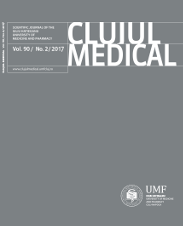ENDOBRONCHIAL ULTRASOUND – ONE YEAR OF EXPERIENCE IN CLINICAL PRACTICE
DOI:
https://doi.org/10.15386/cjmed-655Keywords:
endobronchial ultrasound, fine-needle biopsy, lung adenocarcinoma, mediastinal neoplasms, pulmonary medicineAbstract
Background and aim. Endobronchial ultrasound (EBUS) is a recent minimally invasive, safe examination method for the mediastinum, with a good diagnostic precision.
This method makes possible real time examination with transbronchial fine needle aspiration, diagnostic transbronchial needle aspiration (TBNA) and staging of non-small pulmonary tumors, as well as diagnosis of mediastinal and hilar adenopathies of various causes.
Methods. We present the experience of the Bronchoscopy Department of the Pulmonology Clinic of Cluj-Napoca with EBUS-TBNA as a tool for the diagnosis and staging of tumors in contact with the bronchial wall and mediastinal and hilar adenopathies of unknown etiology. During the period August 2014 – January 2016 we examined 152 patients with no direct or indirect signs of lung tumor in traditional bronchoscopy. Rapid on site evaluation (ROSE) was available for all patients.
Results. Our study is a retrospective study of 152 EBUS-TBNA examinations. The average age of our patients was 54.43 years and 64% came from urban and 36% from rural background. EBUS-TBNA brought the final histological confirmation (tumors, sarcoidosis, limphoma) in 82.8% of the cases. A tumor confirmation was obtained in 95% of the patients who were suspected of having tumor.
For a better understanding of the importance of this method in the daily clinical practice we present a case of peripheral pulmonary neoplasm with mediastinal and hilar adenopathies, where the contribution of EBUS-TBNA to a rapid diagnosis was essential.
Conclusion. By the introduction of this method in our country one year ago, we can diagnose patients with lung and mediastinal tumors, which cannot be diagnosed by traditional bronchoscopy. This brings a valuable contribution to the improvement of lung cancer staging and diagnostic.
Downloads
Additional Files
Published
How to Cite
Issue
Section
License
The authors are required to transfer the copyright of the published paper to the journal. This is done by agreeing to sign the Copyright Assignment Form. Whenever the case, authors are also required to send permissions to reproduce material (such as illustrations) from the copyright holder.

The papers published in the journal are licensed under a Creative Commons Attribution-NonCommercial-NoDerivatives 4.0 International License.

